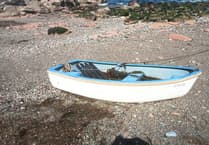There have been multiple sightings of the northern lights from the island this week.
Known as aurora borealis, the phenomenon was spotted by many skywatchers on Tuesday and Wednesday.
There have been sightings in Peel, Ramsey, the Point of Ayre and the west coast of the island.
Howard Parkin, author and vice-chairman of the Isle of Man Astronomical Society, explained it is ’not unusual’ to see the aurora borealis from the island.
He said: ’Anywhere with a good northern horizon is likely to get views of the lights.
’It is elusive, you don’t see it all the time but it is something we do get from time to time.
’It tends to focus more on the end of September and the end of March, that’s when we tend to see aurora at its best.
’Although it’s great to see it in November.’
The best weather conditions for it to occur are clear skies.
’Of course, with the skies the last couple of nights, there’s been a very strong chance of seeing some aurora,’ he added.
The lights are from a ’coronal mass ejection’ of plasma from the sun, says Mr Parkin.
When this reaches the Earth it can impact on its high-altitude atmosphere and cause an ’auroral display’ if in a particular direction.
Mr Parkin, who has just released a book called Space for Dark Skies which explains the aurora borealis phenomenon, stressed we may see more sightings like this in the future.
He added: ’The sun goes through a cycle every 11 years, the last peak was 2013, the next one will be 2024.
’As astronomers, we’re looking for the next auroral display.
’We’re expecting there will be an increase in activity as we head towards that peak in 2024, we’re a few years off yet.’
He gave his recommendations for anyone hoping to see the northern lights.
Mr Parkin said: ’The recommendation to readers is to find somewhere with a good, northern location. Statistics tell you around about midnight is the best time.
’Always keep looking north and keep an eye out for it.
’What is most frustrating is when we get predictions for the aurora, which is very difficult to predict, you might get an aurora a few days later but you can’t predict when.’
The auroral oval, the most common place to see the northern lights in the world, mostly covers high-latitude regions such as the Arctic, Antarctic, most of Alaska, northern parts of Canada, the southern half of Greenland, Iceland, northern Norway, Sweden and Finland.
They usually display patterns that cover the entire sky.





Comments
This article has no comments yet. Be the first to leave a comment.